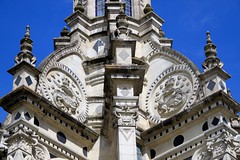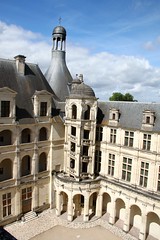Chateau de Chambord was built by Francis I as a royal hunting lodge but became the largest Renaissance castle in the Loire Valley.
The royal hunting lodge Chateau de Chambord was started in 1519 by the Valois King Francis I. It was favored by kings fond of hunting such as Henry II and Louis XIV. Although never fully completed, Chambord is still the largest chateau in the Loire Valley. Rarely occupied for any continuous period of time, Chateau de Chambord kept much of its original appearance. Some of the interior was altered during the eighteenth century when the chateau was inhabited by Stanislaus Leszczynski and the Maréchal de Saxe but the basic structure is still the unadulterated original – as impressive now as when it impressed Emperor Charles V. Buy skip-the-line tickets online from Tiqets.
Chambord – A Hunting Lodge for Francis I
French king Francois I (often Francis I in English) commissioned the building of Château de Chambord as a hunting lodge in 1519. Although medieval in structure with a central keep, round bastions at the corners, two wings, two further towers, and an enclosing curtain wall, the execution of the building is Renaissance, a style Francois became familiar with during his campaigns in Italy.
Although intended as a hunting lodge, Château de Chambord became by far the largest chateau in the Loire region. Its extravagant dimensions are 156 m long and up to 56 meter tall. The 426 rooms made do with 282 fireplaces and 77 staircases. Over 800 sculpted columns keep it all together.
Francois I hoped to impress the Holy Roman Emperor Charles V with the chateau and he did. The emperor visited in 1539 and described Chambord as a summary of what human industry can achieve.
Francois I died in 1547 and during his 32 year reign only spent 72 days at Chambord. At the time of his death, only the keep and royal wing had been completed. His son, Henry II, and later Louis XIV – both kings fond of hunting – continued construction at the castle.
Louis XIV had some rooms altered at Chambord to reflect his notions of what the royal protocol demanded. These State Apartments has a series of anterooms, staterooms, and private rooms as were customary at the Palace of Versailles.
As was customary with many royal chateaux during the sixteenth century, the rooms were only furnished for the duration of the king’s visits. Modern-day visitors will thus see only the architectural structure from the early period but this is impressive enough.
See Touring Chateau de Chambord for a more detailed description of the interior of the castle.
Chambord in the Eighteenth Century
It was only during the eighteenth century that Château de Chambord was occupied continuously for any period of time. However, the castle remained a rather uncomfortably residence and was still lived in for only around 12 years.
The first permanent resident was the father-in-law of King Louis XV – Stanislaus Leszczynski, the disposed king of Poland. He stayed in Chambord from 1725 to 1733 but after loosing the Polish throne a second time in 1736 preferred to stay in Lorraine.
From 1745 to 1750, the Maréchal Maurice de Saxe lived in Chateau de Chambord as reward for services rendered to the French army. This interesting character was the son of Saxon elector Augustus the Great. He was one of eight illegitimate children that Augustus acknowledged although rumors had the actual number over 350. He was hugely successful in the service of various European armies but it was in the French army that he really excelled and ended as marshal general of France. He died at Chambord – probably pneumonia but according to gossip it could also have been as a consequence of a duel over the wife of another noble.
At Chambord, he had ceiling lowered and rooms made smaller in an attempt to make it easier to heat the castle in winter. He introduced the tiled heaters brought over from his home country of Saxony. Much of Chambord and its furnishings reflect the look from this period.
Chambord After the French Revolution
After the French Revolution, Chambord was stripped of its last furnishing and art. Even some of the floorboards and wood paneling were sold. The castle eventually ended up in private hands.
The last notable owner of the chateau was the Comte de Chambord, the last Bourbon, who owned the castle from 1821 until his death in 1883. (The Bourbon line of succession became complicated during the nineteenth century.) After the defeat of the Second French Empire by Prussia in 1871, the count was offered the French throne. He refused, as he was not prepared to accept the tri-color as flag. France reverted to a republic. Although owning Chambord for six decades and improving the estate, he spent only three days in the chateau.
Chambord became national property in 1930. At the outbreak of the Second World War, Chambord housed several artworks from the Louvre including the Mona Lisa and Venus de Milo.
As a national monument, it is in a beautifully restored condition but, like in any old house, maintenance work continues endlessly. Château de Chambord was inscribed on the UNESCO World Cultural Heritage list in 1981 – the rest of the Loire chateaux were only added 19 years later.
More on Château de Chambord:
- Brief History of Chateau de Chambord
- Touring the Interior of Chambord
- Transportation to Château de Chambord
- Photos of Chambord on Flickr
- More Chateaux in the Loire Region of France
- Buy skip-the-line tickets online from Tiqets.
- Book day-trip tours from Paris to Loire Valley Chateaux.




